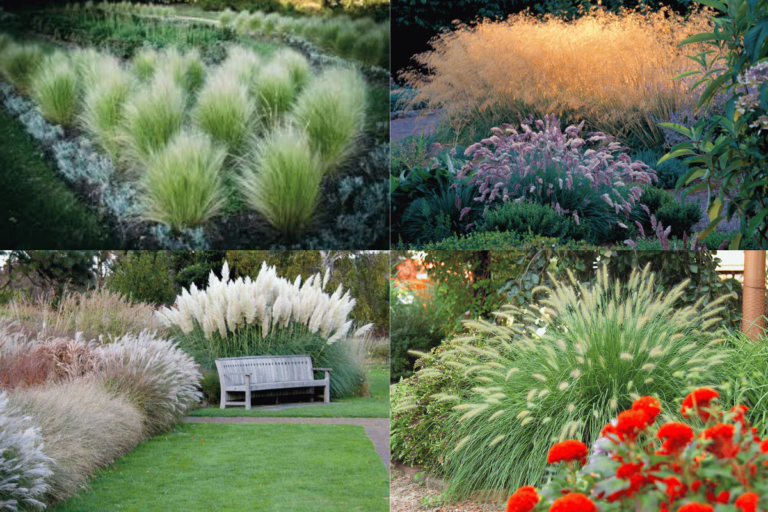Grasses on the Top for Landscaping
Ornamental grasses provide texture, movement and colour to your garden. They require little maintenance, are drought-resistant and come in different sizes and forms. Here are some of the best ornamental grasses for landscaping:
Fountain Grass (Pennisetum): This fountain-like plant has arching leaves and feathery flowers. It comes in green, burgundy, or variegated colours. Fountain grass fits well in borders, container plants, or mass planting situations. It requires full sun and well-drained soil.
For example, This includes ‘Rubrum’- a popular variety with pinkish flower spikes and burgundy foliage.
Maiden Grass (Miscanthus): This tall grass with narrow leaves and fluffy inflorescences at the ends. It gives the garden an up-and-down impression. Maiden grass is suitable for borders, screens, focal points, etc. It needs whole sunlight to partially shade and well-drained soil.
For example, ‘ Gracillimus’ has silvery flower plumes and delicate textured foliage.
Blue Fescue (Festuca glauca): Compact clumps of blue-grey leafed grass form Blue fescue plants, which look good in rock gardens, border lines or containers. It grows best in sunny places where there is no water logging.
For example, you can mention that this is ‘Elijah Blue’, a famous type that exhibits intense blue colouration and tidy mounding shape.
Switchgrass (Panicum virgatum): Switchgrass forms upright clumps bearing air panicles all around it; thus, it provides a year-round interest through seed heads of attractive appearance coupled with its colourful foliage. In addition to these characteristics, switchgrass can be planted in border meadows or areas where it can be naturalized. It grows best in well-drained soil with partial shade and full sun.
For example, One variety of switch grass called ‘Shenandoah’ has red-tipped foliage that turns burgundy in the fall.
Care and Maintenance for Ornamental Grasses
Ornamental grasses are pretty easy to care for but still need attention to make them look perfect. Here are some guidelines on how to properly care for ornamental grasses:
Planting: Depending on the species, Ornamentsingrass requires well-drained soils and enough light. While most ornamentals require sun, others will still survive without it.
For example, Place blue fescue under direct sunlight to maintain its lively colour.
Watering: Regular watering is necessary immediately after planting any grass until it gets established. Once developed, most ornamental grasses have a high level of water tolerance as they only require less watering. Water deeply but infrequently so as root s can go deep into the ground.
For example, fountain grass should be given deep watering once every week throughout dry spells.
Fertilizing: To assist their growth, apply balanced slow-release fertilizer during spring. Avoid too much fertilization, which might only lead to excessive leaf growth and weak stems.
For example, optimal growth could be achieved by applying a 10-10-10 fertilizer during early spring.
Pruning: In late winter or just as spring begins before new shoots, grow back and cut down your ornamental grasses through sharp pruners or shears. Removing last season’s verdancy till a few inches above earth levels will help rejuvenate and promote fresh, vigorous growth.
For example: Cut back Maiden Grass about six inches above ground level in late winter.
Dividing: Every several years, divide these plants to help them maintain good health and grow vigorously. They are dug up in either spring or autumn and then separated using a sharp spade/ knife into smaller units. Afterwards, they should be watered adequately while still at the same depth.
Example: To prevent overcrowding, divide switchgrass every 3-4 years.
For pests and diseases, watch out, especially for rust or fungus illnesses in the grasses. Affected leaves should be removed and treated using appropriate organic or chemical remedies.
Example: Inspect regularly to find out if they have any signs of rust or fungal diseases and then apply the proper treatment.
Those who want to keep the beauty of these types of grass around their lawns need to understand that such tips on care and maintenance are very important. Besides adding beauty to your landscape, they can also help conserve your soil by providing wildlife habitat areas, thereby reducing soil erosion through ornamental grasses.
Explore More Gardening Tips and Ideas
- Growing Bonsai: Tips for Miniature Tree Enthusiasts
- Buying Bonsai: Tips for Selecting Your Perfect Tree
- Bonsai Potting: Essential Tips for Tree Care Success
- Bonsai Maintenance: Essential Care for Tiny Trees
- Mastering the Art of Shaping Bonsai: A Beginner’s Guide
Source: Best Grasses For Ornamental Garden


